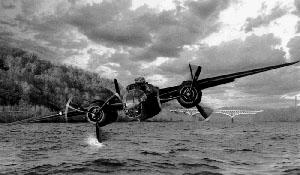© 2006 All Rights Reserved. Do not distribute or repurpose this work without written permission from the copyright holder(s).
Printed from https://danginteresting.com/the-lost-bomber/

In the middle of the afternoon on January 31, 1956 a B-25 bomber crash-landed into the Monongahela river near Homestead, Pennsylvania. All six aboard survived the impact, though two of them died before they were saved from the cold water. It was an unfortunate accident, and in the following weeks a search for the sunken plane was conducted.
The odds of finding the plane seemed pretty good – at the crash location the river was only 500 to 1,000 feet in width and 25 to 35 feet in depth. In comparison, a B-25 bomber is 52 feet long, 17 feet tall and has a wingspan of 67 feet. It took 15 minutes to sink underwater, and there were plenty of witnesses, so its last location above water was well known. It did not seem that finding the bomber would be a difficult task; yet after two weeks of hard searching, the plane was still missing and the operation was abandoned. So where did the B-25 really go?
The conspiracy theories flew fast and loose on this mystery. The most popular story was that the plane secretly carried some important, confidential cargo and was recovered incognito by the government. Anything from nuclear bombs to aliens were said to be inside the plane. As such, in the middle of the night a squad of elite government cover-up men retrieved the plane from the river, and had it shipped away. There were, of course, eyewitnesses who saw this secret operation. And the public search? Nothing but a hoax to cover for the real rescue. Oh, there was also an undercover seventh member of the crew who was pulled from the river. And Glenn Miller was aboard, they flew into the Bermuda Triangle, and…

Like most conspiracy theories, it’s rather preposterous. The government’s side of the story is both less ridiculous and less intriguing. According to military representatives, the plane was carrying no secret cargo – instead, it was to deliver two people to Harrisburg, as well as pick up airplane parts. Due to a malfunction the plane ran out of fuel on the way to its destination. The crew tried to turn around and get to a nearby airport, but by the time they realized they were under-fueled they were just too far away. The engines sputtered to a halt over the Mon, and the pilot crashed it there.
As for the search operation, the plane was almost found, but not quite. On the second day they hooked onto what appeared to be the wing of the plane, but the hook became unhinged and the plane sank back into the river. In the following days the river was dragged by searchers, resulting in a few broken cables due to other objects underneath the water, but no plane was found. In two weeks the government gave up.
While it’s nice to think that the U.S. government could be so powerful as to secretly recover and ship away a large bomber in the middle of the night, that’s hardly realistic. Still, it’s difficult to believe that a plane could so easily get lost in such a shallow river. Where did the plane go?
In 1995 a few people calling themselves the B-25 Recovery Group decided to give the search another attempt. Headed by John Uldrich, they did everything in their power to find the lost B-25. After a few years of heavy research, the group claims to know the exact location of the plane:

…the B-25 is buried approximately 150 feet off the left descending bank of the Mon, at mile point 4.9, at a place know to river men as Bird’s Landing. Bird’s Landing was once a tie-off spot for barges. Bird’s Landing was also a favorite stopping place for “gravel pirates” who dredged gravel from the river and sold it to customers along the Mon, Allegheny and Ohio rivers. It was the activities of these entrepreneurs that created the open pit that would eventually be the burial site of the B-25. Somewhere in that filled in gravel pit, under 32 feet of water and 15 feet of silt lay the remains of a B-25.
There you have it: gravel pirates and their underwater tombs. The plane had been buried beneath a soft layer of silt that no one knew existed in the 1950s. Who would have thought that such an innocent action as stealing muck from the bottom of a river could have such plane-disappearing consequences? The latest news with the recovery operation is that they need $25,000 to rent the proper equipment to at least confirm the location of the plane – money that still has not been obtained. Maybe they could try their hands at the swashbuckling trade of gravel-piracy.
© 2006 All Rights Reserved. Do not distribute or repurpose this work without written permission from the copyright holder(s).
Printed from https://danginteresting.com/the-lost-bomber/
Since you enjoyed our work enough to print it out, and read it clear to the end, would you consider donating a few dollars at https://danginteresting.com/donate ?